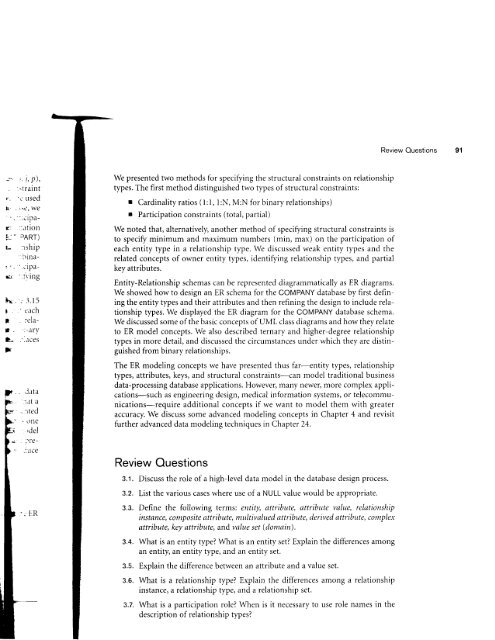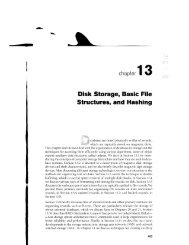this pdf excerpt
this pdf excerpt
this pdf excerpt
Create successful ePaper yourself
Turn your PDF publications into a flip-book with our unique Google optimized e-Paper software.
:<br />
t-<br />
Ft-<br />
I<br />
t<br />
T.<br />
&-<br />
F<br />
,. t, p)'<br />
.traint<br />
r used<br />
r\c, we<br />
.. -:.-^<br />
.,! lPdr.rtion<br />
sART)<br />
:rship<br />
: lrina-<br />
' cipa-<br />
' ti irro<br />
''. "'o<br />
: -1.15<br />
' cich<br />
- rela-<br />
':-i1f y<br />
.'..lces<br />
J ata<br />
'.r.lt a<br />
,.:rted<br />
. t)11€<br />
'.lel<br />
',trg-<br />
-:uce<br />
We presented two methods for specifying the structural constraints on relationship<br />
types. The first method distinguished two types of structural constraints:<br />
r Cardinality ratios ( l: l, 1:N, M:N for binary relationships)<br />
n Participation constraints (total, partial)<br />
We noted that, alternatively, another method of speciflring structural constraints is<br />
to speciff minimum and maximum numbers (min, max) on the participation of<br />
each entity type in a relationship type.We discussed weak entity types and the<br />
related concepts of owner entity types, identiffing relationship types, and partial<br />
key attributes.<br />
Entity-Relationship schemas can be represented diagrarnmatically as ER diagrams.<br />
We showed how to design an ER schema for the CoMPANY database by first defining<br />
the entity types and their attributes and then refining the design to include relationship<br />
types. We displayed the ER diagram for the COMPANY database schema.<br />
We discussed some of the basic concepts of UML class diagrams and how they relate<br />
to ER model concepts. We also described ternary and higher-degree relationship<br />
types in more detail, and discussed the circumstances under lvhich they are distinguished<br />
from binary relationships.<br />
The ER modeling concepts we have presented thus far-entity types, relationship<br />
types, attributes, keys, and structural constraints-can model traditional business<br />
data-processing database applications. However, many newer, more complex appli-<br />
631isn5-5ush as engineering design, medical information sy.stems, or telecommunications-require<br />
additional concepts if we want to model them with greater<br />
accuracy. We discuss some advanced modeling concepts in Chapter 4 and revisit<br />
further advanced data modeling techniques in Chapter 24.<br />
Review Ouestions<br />
3.'l . Discuss the role of a high-level data model in the database design process.<br />
3.?. List the various cases where use of a NULL value would be appropriate.<br />
3"3. Define the following terms: entity, attribute, attribute value, relationship<br />
instance, composite attribute, multivalued attribute, derived attribute, complex<br />
attribute, key attribute, and value set (domain).<br />
3.4. What is an entity type? What is an entity set? Explain the differences among<br />
an entity, an entity type, and an entity set.<br />
3..$. Explain the difference between an attribute and a value set.<br />
3.6. What is a relationship type? Explain the differences among a relationship<br />
instance, a relationship type, and a relationship set.<br />
3"7. What is a participation role? When is it necessary to use role names in the<br />
description of relationship types?<br />
Review Ouestions














